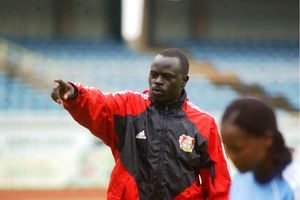Premium
Battlegrounds: 10 counties that will determine who wins presidential contest
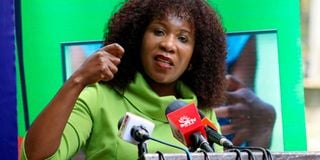
Infotrak Chief Executive Officer Angela Ambitho during a press briefing at the company's offices in Lavington, Nairobi.
Both Deputy President William Ruto and main presidential election rival Raila Odinga have over the past one month concentrated their respective campaigns in 10 crucial counties with a total of 3.6 million votes.
Those are also the counties recent opinion polls have classified as battlegrounds, where the vote could go either way.
The 10 counties, according to an Infotrak Research & Consulting poll released yesterday, are Mombasa and Tana River at the Coast, Marsabit and Isiolo in North Eastern, Narok and Samburu in the South Rift, Nakuru in Central Rift, and Trans Nzoia, Bungoma and Vihiga in Western.
A Nation analysis of the rallies DP Ruto of the Kenya Kwanza Alliance and Mr Odinga of the Azimio la Umoja One Kenya Coalition Party have held over the past month since June 13 show heavy focus on these regions whose vote will tilt the poll outcome.
Mr Odinga, who is fighting to ward off his arch-rival in his perceived coastal strongholds, yesterday embarked on an extensive campaign tour of the region where he will camp until Friday, holding four to six rallies a day.
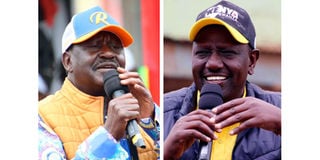
Azimio la Umoja leader Raila Odinga and Deputy President William Ruto.
The DP, on the other hand, has been to the Coast for a three-day tour in the past month, covering Mombasa, Kwale, and Kilifi.
Vihiga, Trans Nzoia and Bungoma Counties in western Kenya with a combined 1,355,622 registered voters are also fashioning into key battlegrounds where DP Ruto is eating aggressively into a vote base previously dominated by his rival.
“The undecided of 26 per cent makes the region a battleground with Vihiga, Bungoma and Trans Nzoia being too close to call,” said Infotrak CEO Angela Ambitho.
DP Ruto is on a five-day tour in Western, and has addressed at least five rallies every day from Monday. Yesterday, he said the race will be decided by Western.
With slightly more than three weeks to the August 9 elections, the two main contenders are only separated by six percentage points, with 16 per cent of the 22.1 registered voters yet to decide who to vote for among the four presidential candidates, the Infotrak poll showed.
If the elections were held between July 2 and 7, 2022 when the survey was conducted, Mr Odinga would have garnered 43 per cent or 9.4 million votes.
The DP, on the other hand, would have received 37 per cent or 8.1 million votes.
The numbers are not much different from a Tifa poll released two days before, but with fieldwork much earlier between June 25 and June 30, which put the Azimio presidential flag bearer marginally ahead of Mr Ruto with 42 per cent to 39 per cent respectively, with the three per cent margin making the race statistically a dead heat.
Tifa did not explain why it took such a long time to release their poll results from the time of data collection, which could make the numbers obsolete in the fluid political situation.
The wild card in both polls is provided by ‘legalise marijuana’ campaign of Roots Party candidate George Wajackoyah, a distant third place at four per cent in both polls, but which could be enough to prevent either Mr Odinga or Mr Ruto getting past the 50 per cent mark, thus forcing them into a run-off.
The fourth candidate in the race, Mr David Mwaure of Agano Party, hardly registers a blip.
The Infotrak poll was conducted through computer assisted telephone interviews with a margin of error of +/-1 per cent with a sample size of 9,000 respondents picked across all the nine regions in the country proportional to the number of registered voters.
The poll showed that Mr Odinga has grip of 21 counties spread across the country including Siaya, Homa Bay, Kisumu, Migori, Kisii, Nyamira, Nairobi, Busia, Kakamega and Kajiado. Others are Makueni, Machakos, Kitui, Kwale, Lamu, Kilifi, Taita Taveta, Garissa, Wajir, Mandera, and Turkana.
On the other hand, the DP draws his strongholds from Mt Kenya and Rift Valley with 16 counties in his fold.
The counties include Laikipia, Embu, Meru, Kiambu, Murang’a, Nyandarua, Tharaka-Nithi, Nyeri, Kirinyaga, Kericho, Bomet, Uasin Gishu, Elgeyo-Marakwet, Nandi, Baringo and West Pokot.
At the Coast, Mr Odinga’s traditional stronghold with 1.96 million voters, the DP lost ground with his popularity reducing from 29 per cent in June to 27 per cent. However, Mombasa with 641,913 voters and Tana River 141,096 voters are now battlegrounds with Mr Odinga’s popularity in Mombasa at 46 per cent, Dr Ruto at 27 per cent and 20 per cent being undecided voters.
In Tana River, the two are neck and neck with Mr Odinga at 43 per cent and Dr Ruto at 40 per cent, with the former prime minister having gained by one per cent but his political nemesis maintaining his popularity with voters yet to make up their minds being 11 per cent.
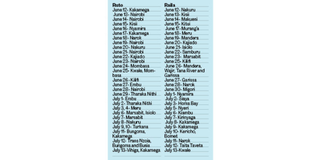
But there are interesting changes in Lamu with 81,453 voters and Kwale’s 328,253 voters. In Kwale, Mr Odinga’s popularity has jumped from 42 per cent in June to 51 per cent while Dr Ruto’s approval dropped drastically from 35 per cent in June to 25 per cent.
In Lamu, Mr Odinga leads with 46 per cent with Dr Ruto trailing him with 29 per cent having seen his approval dip from 43 per cent in June while Mr Odinga was only at 34 per cent.
“We have seen a complete flip in Lamu and Kwale... Raila has gained in both two counties but Mombasa, the vote-rich county, is still playing out as a battleground,” Ms Ambitho said.
In the Lower Eastern region, Ukambani, with 1.7 million votes, Mr Odinga gained the most with 13 per cent swing to his side from 41 per cent in June to 54 per cent while the DP’s popularity took a beating reducing from 32 per cent to 25 per cent over the same period.
The shift is attributed to Wiper party leader Kalonzo Musyoka’s return to the Azimio fold.
Both contestants have visited the region twice this month, with two-day tours for the former, and three for the latter, and which saw both of them traverse the three counties.
In Mt Kenya with 4.7 million votes, Mr Odinga’s loss was DP Ruto’s gain as the deputy president popularity jumped from 52 per cent to 55 per cent while Mr Odinga’s approval currently stands at 24 per cent from 27 per cent in June.
Both the Infotrak and Tifa polls show that the expected boost in Mr Odinga’s Mt Kenya ratings after naming Ms Martha Karua as his running mate did not materialise.
“Ruto’s gains are in Embu, Laikipia, and Murang’a, but Mr Odinga’s key areas are Meru at 32 per cent, Tharaka Nithi and Kiambu, both at 28 per cent. The bottom line, however, is that the region is indisputably Ruto’s stronghold,” Ms Ambitho said.
In the past one month, both Ruto and Mr Raila camped in the mountain, with the DP taking a five-day sweep of the region, and the former prime minister camping there for three days.
Interestingly, according to Infotrak, Mr Odinga ate into his main rival’s traditional strongholds of South and North rift regions by five and four percentage points respectively, with his popularity now at 30 per cent from 25 per cent in June in South Rift, and 24 per cent from 20 per cent in June in North Rift.
The UDA leader lost ground in South Rift with 1.7 million votes by five percentage points, with his approval currently at 54 per cent but gained in North Rift with 2.8 million votes by two percentage points to 58 per cent.
Mr Odinga’s approval in Narok has jumped to 48 per cent from 42 per cent in June while the DP maintained his popularity at 43 per cent.
Nakuru County with more than one million votes is also turning to be a battleground with Raila having gained by six points to 30 per cent and Ruto at 48 per cent, with a huge 17 per cent being undecided.
Mr Odinga’s Nyanza political bedrock with 3.1 million votes did not change even though the deputy president’s support reduced by one per cent.
In the capital city, Nairobi, with 2.4 voters, Mr Odinga is still the man to beat with his approval standing at 49 per cent to DP Ruto’s 30 per cent.
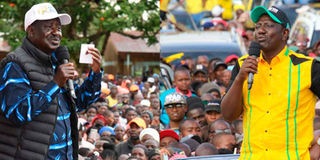
Azimio presidential candidate Raila Odinga (left) and his Kenya Kwanza counterpart William Ruto.
Of much interest to the main presidential candidates should be the still high number of undecided voters, 16 per cent (3.6 million votes), according to Infotrak and 10 per cent according to Tifa.
However, the number of the undecided voters have been shrinking, with a May Infotrak poll showing there were 4.4 million voters yet to make up their minds.
According to Infotrak, the vote-rich Mt Kenya region leads with 21 per cent of undecided voters followed by Nyanza at 14 per cent, North Rift 13 per cent, Western 12 per cent and Nairobi 11 per cent. The numbers in the other regions are below nine percent.
The undecided are mostly aged between 27 and 45 years, making up 68 per cent, with those aged between 27 and 35 years standing at 38 per cent.
For Tifa, in terms of gender, three times more women than men remain undecided (15 per cent versus five per cent).
With regard to age, there is no statistical difference in their levels of support, but Prof Wajackoyah is clearly more favoured by younger would-be voters (seven per cent in the 18-24 age-group versus two per cent among those older than 35).
Ms Ambitho pointed out that the age cohort most affected by the high cost of living is not the young voter of between 18 and 26 years but people leaving college or universities, starting their lives, their families, and getting jobs.
“These are the people who are feeling the pinch of the economy and therefore we’re not be surprised that the undecided numbers have moved from 32 per cent in June to 38 per cent currently,” Ms Ambitho said.





